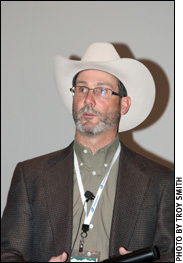Preventing Lameness
Experts share how and why cattle become lame.
by Troy Smith for Angus Productions Inc.
Back to the Angus Beef Bulletin EXTRADENVER (Feb. 2, 2011) — A discussion of the causes and costs of lameness in cattle drew producers representing the cow-calf, stocker and cattle-feeding segments to the 18th Annual Cattlemen’s College Wednesday, Feb. 2, during the 2011 Cattle Industry Convention. Zinpro nutrition researcher Connie Larson and Nebraska-based feedlot veterinarian Tom Edwards talked about how and why cattle become lame and shared treatment and prevention recommendations.

About 16% of cows and 31% of bulls going to slaughter exhibit lameness at delivery and may be discounted as a consequence, shared Connie Larson, Zinpro nutrition researcher.
Results of the non-fed (market cow and bull) beef quality audit indicate that delivery of non-ambulatory or “downer” cattle to slaughter facilities has been nearly eliminated, Larson said. However, about 16% of cows and 31% of bulls going to slaughter exhibit lameness at delivery and may be discounted as a consequence. Producers suffer additional economic loss when breeding animals on the ranch exhibit reduced reproductive performance and longevity.
Larson said diminished performance and even death among growing calves, as a result of lameness, also rob producers of profits, but lameness issues can also jeopardize the industry’s image from the standpoint of animal welfare.
“It only takes one animal captured on video to give the industry a black eye,” warned Larson.
Edwards, of Midwest Feedlot Services Inc., cited data showing that of all Nebraska feedlot cattle requiring veterinary treatment, 16% are treated for lameness. From losses attributed to overhead, chronics and treatment expense, direct costs can exceed $126 per head. Edwards said lameness can reduce average daily gains by 0.70 pound (lb.) and result in the need for an additional five days on feed. Lameness issues consistently result in a feedlot mortality rate of about 3%.

"If the head bobs up, it's an indication of lameness in a front foot, as the animal tries to take weight off the painful foot," said Nebraska feedlot veterinarian Tom Edwards. "If the head bobs down, [the animal] is trying to take weight off a rear foot."
Discussing causes of lameness, Edwards said the vast majority of cases involve footrot or toe abscesses. Footrot, he said, results from infection between the toes, when ubiquitous bacterial organisms in the soil enter through a break in the skin. Toe abscesses, which Edwards referred to as “concrete toxicity," generally result from toe abrasions caused by rough or sharp surfaces. Another foot malady known as hairy heel wart is a digital dermatitis or lesion on the back of the foot most often promoted by wet, muddy pen conditions. Other causes of lameness are joint infections, stemming from injury, and laminitis (founder) resulting from digestive upset.
Edwards noted that the choice of proper treatment depends on accurate diagnosis of foot ailments. However, some signs may not be visible. Edwards advised producers to watch a lame animal in motion to first determine which foot is affected and needs to be examined.
“Watch the head-bob,” he said. “If the head bobs up, it’s an indication of lameness in a front foot, as the animal tries to take weight off the painful foot. If the head bobs down, [the animal] is trying to take weight off a rear foot. That’s a real simple way to tell, but one that’s not always understood.”
Edwards offered recommendations for treatment, with respect to various diagnoses, but urged prevention through animal husbandry. He urged producers to pay attention to pen maintenance and facilities, and particularly to the footing in cattle loading and processing areas. He also said the common practice of spreading sand to improve traction in concrete alleys or in truck beds often contributes to lameness issues, especially toe abscesses.
Larson agreed that good management practices, including pen maintenance and low-stress handling methods, can reduce the incidence of lameness. She also stressed the importance of balanced nutrition, noting how trace minerals, including zinc, manganese and selenium (in balance with vitamin E) are important to maintaining hoof health.
###
Editor’s Note: The above article was written under contract or by staff of Angus Productions Inc. (API). It may not be reprinted without express permission of API. To request reprint permision, contact the editor at 816-383-5200.
www.4cattlemen.com is an event coverage site provided by the editorial team at Angus Productions Inc. (API), publisher of the Angus Journal, the Angus Beef Bulletin, the Angus Beef Bulletin EXTRA and the Angus e-List. For questions about this site, to submit an article for our consideration, or to report a broken link, contact the editor at 816-383-5200; 3201 Frederick Ave., Saint Joseph, MO 64506.
API claims copyright to this web site as presented. We welcome educational venues and cattlemen to link to this site as a service to their audience.

